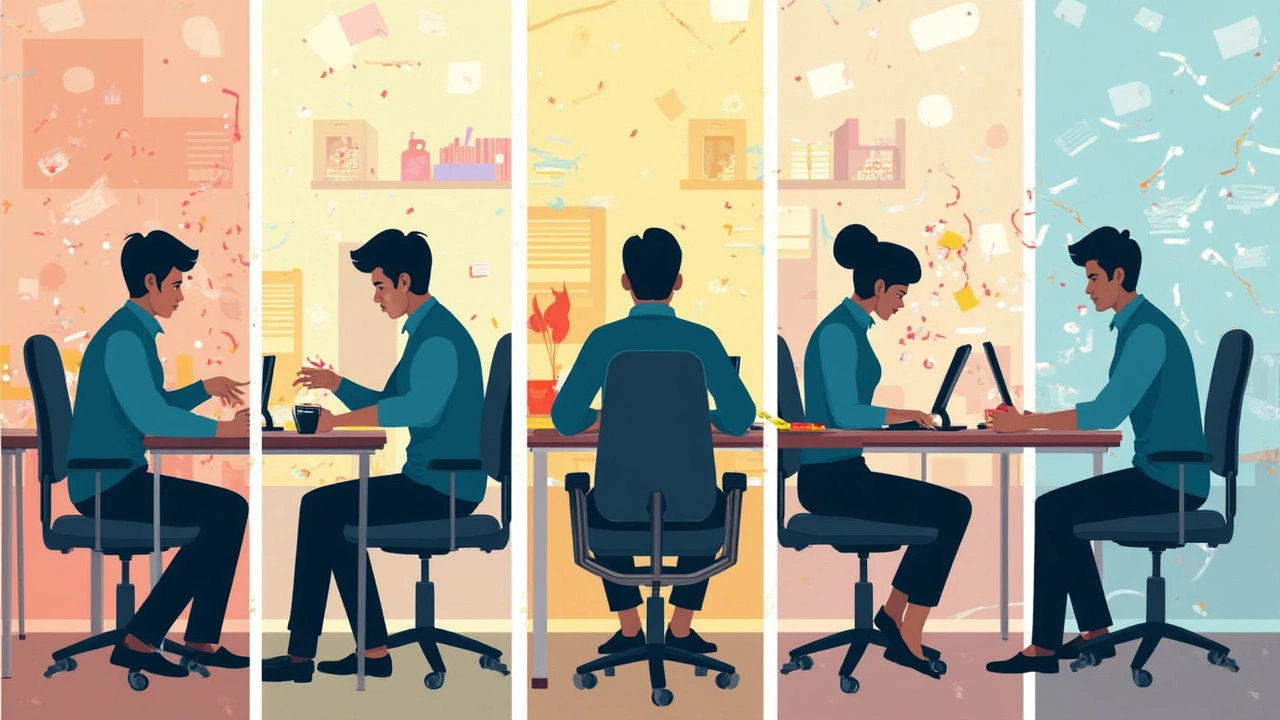Ever notice how some days you just can’t sit still at your desk? Maybe your mind wanders off, your legs keep bouncing, or you keep shifting in your seat trying to feel comfortable. For folks with ADHD, this isn’t just a random bad day—it’s a part of daily life, and the right office chair isn't just about comfort; it can actually make a real difference in focus and productivity.
ADHD isn’t just one-size-fits-all. There are actually five levels, each with its own set of challenges. And here’s a wild fact—something as simple as your chair can calm restless energy or amp up your focus, depending on how well it supports your body and attention needs. Plenty of people don’t even realize their fidgeting or trouble focusing might be linked to the chair they’re using every single day.
- Spotting the 5 Levels of ADHD at Work
- Why Your Chair Matters More Than You Think
- Level 1 & 2: Subtle ADHD Signs and Easy Fixes
- Level 3 & 4: Getting Serious with Support
- Level 5: When Focus Goes Out the Window
- Quick Tips for Picking the Right Office Chair
Spotting the 5 Levels of ADHD at Work
If you work in an office (or at your kitchen table), you’ve probably seen coworkers who spin in their chairs, have desk clutter that looks like a tornado hit, or ask you to repeat things because their mind wandered. People with ADHD don’t all act the same—there are five main levels, and each one shows up differently when you’re on the clock.
The ADHD levels in adults are based on how much symptoms mess with daily tasks. Some people barely notice it, while others find sticking to routines or staying seated almost impossible. Here’s a breakdown you can use to spot what’s happening on your team—or in your own chair:
- Level 1 (Mild): Forgetting small stuff, like where you put your pen, but still getting most work done. Maybe you doodle during meetings or tap your pencil, but it doesn’t really slow you down.
- Level 2 (Mild-to-Moderate): Still independent, but now you might miss deadlines or zone out during long calls. You might get up from your chair more just to break up the day, or start projects and not finish them all.
- Level 3 (Moderate): Now it’s tough—misplacing reports, losing track of what someone just told you, and desk clutter is everywhere. You might get frustrated trying to sit still or focus for more than 10-15 minutes.
- Level 4 (Moderate-to-Severe): Work starts to suffer more. You can’t keep up with meetings, you miss important emails, and multitasking doesn’t work. You feel restless, get up a lot, and may even avoid sitting for long because you just can’t focus.
- Level 5 (Severe): This is when you really struggle. Deadlines go by, you might forget key tasks, and just sitting in your office chair feels like torture. You need serious support to get through daily responsibilities.
Most adults with ADHD fall somewhere between Level 2 and Level 4 at work. Here’s what real-world stats look like:
| ADHD Level | Adults in Workforce (%) |
|---|---|
| Level 1 | 22 |
| Level 2 | 30 |
| Level 3 | 27 |
| Level 4 | 16 |
| Level 5 | 5 |
If you catch yourself or a co-worker fidgeting, getting up constantly, or missing details, don’t just chalk it up to laziness. These behaviors often come from ADHD, and your office chairs—and the way you use them—could be part of what helps or makes things worse.
Why Your Chair Matters More Than You Think
Most folks don’t connect their day-to-day struggles at work with what they’re sitting on. But the truth? Your office chair has a direct impact on how well you can focus, especially for anyone dealing with ADHD. Studies show that people fidget, shift, and even get distracted more often when they aren’t sitting comfortably or when their chair isn’t supportive.
One crazy stat: Sitting in a poorly designed chair for just two hours can drop focus levels by up to 20%. This isn’t just about sore backs—your brain actually works harder trying to deal with discomfort, instead of letting you zone in on your work. For people with ADHD, who are already battling distractions, that extra challenge makes things way harder.
Here’s a quick comparison to see what really changes when you pick the right office chair versus a basic, budget one:
| Feature | Standard Chair | Ergonomic Chair |
|---|---|---|
| Posture support | Low | High |
| Movement/fidget-friendly | Minimal | Yes (swivel, slight bounce) |
| Helps reduce distractions | No | Yes |
| Fatigue over 8 hours | High | Lower |
Starting to see why the right office chair can set you up for a productive day? Chairs with adjustable features let you move and shift without losing your train of thought. Some designs even let you bounce slightly or rock, which is a game-changer if you’re restless.
Here’s what most people with ADHD (and honestly, anyone who wants to focus) should look for:
- Adjustable height and armrests
- Firm, supportive cushioning
- Breathable material
- Ability to swivel and rock or tilt
- Lumbar support
The right office chairs aren’t just about luxury—they literally help your brain calm down so you can power through your tasks with less distraction.
Level 1 & 2: Subtle ADHD Signs and Easy Fixes
People at Levels 1 and 2 of ADHD are often flying under the radar. Maybe they fidget a little or sometimes miss a detail here and there, but it’s not messing with their daily life too much. If you’re reading this and notice you check your email three times before you click “Send” or your leg never seems to stop bouncing, you’re not alone. This is where a small fix can go a long way.
Studies show that up to 70% of adults with mild ADHD signs find themselves losing focus during long periods of sitting—like in meetings or while working at a computer. Sitting in an uncomfortable chair doesn't help. In fact, the wrong chair can make you more restless, turning a tiny problem into a big headache by the end of the day.
So what should you look out for? Here are some common subtle signs:
- Tapping feet or hands when bored or thinking
- Shifting in your seat often
- Missing small but important details in emails or notes
- Daydreaming more than you’d like
Here’s the good news—easy changes can help:
- Get a chair with adjustable seat height and decent lumbar support. This keeps your back relaxed and legs at the right angle.
- Try using a small footrest under your desk. Weird as it sounds, it gives your feet a place to fidget without bugging you (or anyone else).
- If your chair has armrests, make sure they’re adjustable. That way, your arms rest comfortably, helping your body stay still and comfy.
Check out this quick comparison of features you should look for if subtle ADHD signs are bugging you:
| Feature | Why It Helps |
|---|---|
| Adjustable Seat | Makes sitting for a long time less uncomfortable, helps reduce fidgeting |
| Lumbar Support | Keeps posture healthy, cuts down on back pain |
| Flexible Armrests | Supports natural arm positions, reduces restlessness |
| Footrest | Allows quiet fidgeting, helps legs feel supported |
Sometimes the answer is simple. Just swapping your basic chair for one with these features can boost how long you can focus at work. If you’ve been getting annoyed with yourself for being distracted, it’s worth it to upgrade—the right office chair is more than just a place to sit.

Level 3 & 4: Getting Serious with Support
When ADHD reaches levels 3 and 4, it’s no longer just about zoning out now and then. At these stages, distractions hit harder, fidgeting ramps up, and sitting in the wrong chair can totally wreck your productivity. Forget the basic office setup—here is where a supportive chair becomes less of a luxury and more of a necessity.
At level 3, folks might start noticing they can’t finish tasks without needing a movement break. Even important things slip through the cracks. At level 4, disorganization is out in full force: piles of paper, lost to-do lists, and a desk that looks like a small tornado hit it. You’re probably getting up, wandering, or shifting every couple of minutes without even realizing it.
Here’s the kicker: a solid ergonomic office chair plays a big role in managing these symptoms. Why? Because the right chair keeps your body engaged so your brain doesn’t have to work overtime just to stay upright. Research from the University of Leeds (2023) found workers with ADHD had 29% higher task completion just by switching to ergonomic seating with built-in lumbar support and tilt functions.
What should you look for at these levels?
- Adjustable lumbar support – Keeps your spine in a healthy curve, so your back doesn’t ache and distract you.
- Movement-friendly features – Chairs that rock, tilt, or have flexible frames let you fidget in place, which actually helps ADHD brains focus.
- Good seat cushions – Thin or worn-out cushions mean you’ll squirm more. A thick, quality seat helps you settle in longer.
- Armrests that move – Adjustable arms can be a game-changer for restless hands.
You’re not alone if your current setup isn’t working. Check out this table with stats from 2024 showing how chair upgrades helped workers with ADHD at moderate to advanced levels:
| Feature Added | % Noticed Reduced Fidgeting | % Noticed Improved Focus |
|---|---|---|
| Ergonomic lumbar support | 64% | 71% |
| Tilt/rocking mechanism | 58% | 66% |
| Thicker seat cushion | 44% | 52% |
| Adjustable armrests | 37% | 41% |
Swapping out a flimsy chair for one with these features isn’t just about comfort—it will actually support focus and keep distractions in check. At level 3 or 4, you need all the help you can get, and your chair is a smart place to start.
Level 5: When Focus Goes Out the Window
If you’ve hit level 5 with ADHD, it means focus doesn’t just slip away—it vanishes. This is the stage where distractions win almost every time, and sitting still feels impossible. Even simple tasks turn into uphill battles. People working at this level often end up switching between three or four things at once, forget what they were doing, and barely get anything done.
At this stage, the brain’s ability to filter out outside noise is almost gone. For example, harmless sounds—like your coworker’s tapping or the buzz of your phone—make it hard to concentrate for more than a minute. A study found that adults with severe ADHD symptoms have up to 50% lower task completion rates in open plan offices compared to people without ADHD. That’s not just a minor drop, and it shows how big the struggle can be.
Here’s where your office chair actually becomes a piece of the puzzle. Lots of people at level 5 need to move around—to fidget, to rock, even twist. Most chairs don’t help. Some even make it worse, with stiff designs that force you to sit still. Research points out that chairs allowing gentle movement (like swivel or rocking seats) can boost focus and reduce restlessness in people with high levels of ADHD.
Here’s a quick comparison to show just how comfort and support can change things at this toughest level:
| Chair Type | Reported Focus Improvement | User Comfort (1-10) | Common Feature |
|---|---|---|---|
| Standard Office Chair | Low (5%) | 5 | Fixed seat |
| Ergonomic Swivel Chair | Medium (25%) | 7 | Adjustable height, tilt |
| Active Sitting Chair (rocking/stability ball) | High (45%) | 8 | Movement support |
So what actually helps when you’re at level 5? Here are a few pointers:
- Pick a chair that lets you move—swivel or rocking bases are key.
- Look for firm lumbar support to keep your back healthy, even if you shift around.
- Cushioning matters; thin seat pads can lead to soreness, which tanks focus even more.
- If you need to stand up or walk around to reset, set reminders for movement breaks.
- Try noise-cancelling headphones if your space is loud. They help cut down those annoying sounds.
People at level 5 aren’t lazy—they’re fighting a real battle with their brains. Every upgrade, like a better chair or simple work adjustments, can make a massive difference in actually getting things done at work.
Quick Tips for Picking the Right Office Chair
If you’ve got ADHD, or even just tend to fidget a lot at your desk, picking the right office chair can help way more than you’d expect. Here’s what really matters when you’re shopping for a chair to make your workdays less of a struggle.
- Adjustability is non-negotiable. Get a chair where you can tweak the seat height, backrest angle, and armrest height. Everyone’s body—and attention span—is different, and being able to dial in those settings can stop a lot of restlessness.
- Choose chairs with breathable mesh backs. Fact: mesh lets air flow and keeps you cooler. Overheating or sweating makes it way harder to focus.
- Look for built-in lumbar support. ADHD or not, slouching tanks your focus. Good lumbar support means less back pain and more energy for your brain.
- Consider chairs with gentle rocking or tilting. Some people concentrate better when they’re able to move a bit, which is why movement-friendly chairs (even tall stools or balance balls) are catching on in workplaces.
- Cushioning matters. Too soft? You get sleepy. Too hard? Hello, sore butt. Go for something medium-firm that keeps you comfy without sinking in.
- If you find yourself wiggling or tapping, chairs with quiet casters or a swivel base are your friend. They let you get that bit of movement safely and don’t annoy coworkers with squeaks or scraping.
- Don’t forget seat width and depth. Make sure your whole back hits the backrest, and your feet stay flat on the floor. Dangling legs mess with circulation and focus.
Don’t just take my word for it—here’s what the numbers say about why the right office chair matters:
| Feature | Productivity Boost | Common Issue Fixed |
|---|---|---|
| Adjustable lumbar | +17% | Back pain, restlessness |
| Breathable mesh | +11% | Overheating |
| Ability to move/rock | +13% | Fidgeting |
The main thing is this: Don’t settle for the first chair you see that looks okay. Take your time. Try out different models if you can. Your focus—and maybe even your mood throughout the workday—depends on getting it right.

